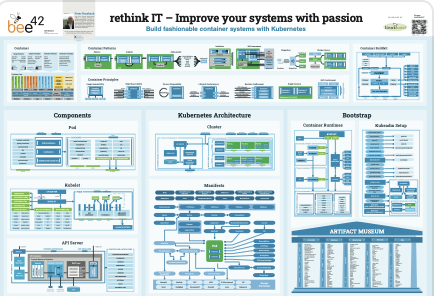10th Kubernetes Birthday

Happy Birthday Kubernetes
The 10th birthday of Kubernetes is a funny moment to be happy. It’s so great that you are born, after so many years of preparation, try outs, failures and corrections. Now after golden ten years, so many people have accepted the easiness of life with Kubernetes. Yeah, at your birthday on 7th June 2014, so many people saw your potential to solve a lot of complicated distributed IT challenges. Now we are proud of you that we had build so many real-scale systems on top of the Kubernetes platform.
The market adoption of the CNCF sustainable ecosystem is truly remarkable. The sharing of numerous valuable projects to create useful systems has become the de facto norm of IT systems. The diverse CNCF community has significantly improved the IT world around the globe. At the recent months, I’ve looked back and seen some reasons why this has happened.
Why is Kubernetes the driver of so many improvements? First, its declarative design is incredibly helpful in explaining and creating systems. Second, it allows us the creation of controlled and excutable abstractions. The resulting real system is self explaining, self scaling, self managed, self healing, resilient, extendable, secure and every time improvable. Nice!
Some people think, “Oh no, it’s too complex for my simple use cases”, while other engineers never want to build systems without the cloud-native ecosystem. In my opinion, the Kubernetes platform ecosystem is the best place for software.
Engineers derive great satisfaction from the process of integrating components, engaging in discussions about various options, and rapidly enhancing their coding skills. As the level of automation in your organization continues to increase, the complexity of the systems under your control also grows. This evolving environment offers engineers the opportunity to refine their expertise and take pride in ensuring that information is delivered accurately and timely to those who need it.
We thrive on the challenge of optimizing systems to produce high-quality, valuable outcomes more efficiently. Our preference is to minimize the occurrence of bugs, alleviate the stress associated with nervous managers, and create a work environment free from unnecessary pressure. By automating repetitive and mundane tasks, we free ourselves to focus on significant improvements and innovative ideas. This not only enhances our productivity but also fosters a sense of accomplishment and progress within the team. Ultimately, our goal is to contribute to the development of robust, efficient systems that advance the organization’s capabilities and meet its evolving needs.
Kubernetes gives us control over truly complex systems. I began my journey in the nineties to build resilient distributed systems. Kubernetes is a real funny solution for a lot of challenges to build stable distrubuted IT systems.
It exist a lot of good documentations, tutorials, books, news, stories, myth, real life experiences about kubernetes, but why kubernetes is helpful to design a distributed systems?
First, it’s essential to have experts who are willing to share their deep knowledge, as well as learners who are eager to understand the intricate details and accept the challenges that come with learning. Secondly, we must recognize the importance of learning from history and accept the principals.
Principals
Here are my favorite Kubernetes principles:
Inclusivity and Help
The ethos of Kubernetes is akin to that of the minion nodes, welcoming every task and valuing continuous improvement. If there’s a lack of talent, there’s a strong culture of embracing improvement.
Adaptability of the Control Plane
The Kubelet initiates with certain pod talents, yet the control plane and the operators has the capability to dynamically extend, modify, and enhance them in real-time. Additional runtimes, storage drivers, observability, or security components can be seamlessly integrated as required.
Stress-Free with Self-Healing
Stress is mitigated through self-healing mechanisms. Overloaded nodes can be cloned to distribute the load effectively, noisy neighbors are addressed, and workloads are reorganized for optimized performance. Automatic crash detection and healing are integral features, ensuring smooth operations without burdening the user.
Continuous Improvement
Continuous enhancement is ingrained in Kubernetes. Multiple versions of components are tested preemptively, minimizing user-facing issues. Component sizes are optimized, dependencies managed meticulously, and real-time monitoring allows for swift problem resolution. Scalability adjustments are made effortlessly to optimize resource allocation.
Environmental Responsibility
Kubernetes ecosystem promotes environmental sustainability by enforcing oversight in system changes, facilitating automated correction post-intervention, and ensuring comprehensive auditability. Users have the flexibility to adjust security maturity levels, contributing to a safer digital ecosystem.
Repetition and Regeneration
The practice of repetition and regeneration is vital. Systems are built with the anticipation of rebuilding from scratch, facilitated by the GitOps flow, comprehensive backups, and meticulous testing. Development and production environments are aligned closely, resilient design patterns are adopted, and data storage is segregated from function processing for robustness.
Executable Design
Kubernetes fosters an executable design paradigm where system descriptions, controller behavior, and real executable containers form the backbone. Open standards are championed, and systems are constructed atop existing, proven components, ensuring efficiency and reliability. In essence, Kubernetes embodies a holistic approach to system design and management, prioritizing inclusivity, adaptability, sustainability, and efficiency at every turn.
We are now happy?
Absolutely! These principles are not just valuable; they are the lifeblood of creating cloud-native distributed systems. Kubernetes isn’t just a tool; it’s a transformative force, reshaping not only your approach but the very fabric of organizations. With a decade of experience under our belts, it’s time to ask: do we simplify complexity or do we add more magic? The answer lies in our ability to cultivate shareable standards, deploy replaceable components, craft elegant abstractions, and forge platforms that serve as springboards for innovation in build automation, data storage, observability, security, trusted network communication, zero trust, functions as services, and AI learning systems.
The digital transformation of societies is an unstoppable juggernaut, hurtling forward at an ever-accelerating pace. There’s no slowing down; there’s only moving forward with gusto!
But fear not, for there’s an army of enthusiastic engineers eagerly awaiting the call to arms. Together, we shall forge resilient fortresses of code, impervious to the storms of chaos and uncertainty. So let’s bask in the glory of our past achievements, and with hearts brimming with excitement, let’s charge forth into the boundless frontier of innovation that lies ahead.
As we gather to celebrate Kubernetes’ 10th birthday, let’s not just revel in the festivities; let’s use this moment as a launching pad for the next wave of revolutionary systems. So, my friends, let’s embrace the power of small wins, and let’s start tomorrow or, better yet, after a joyous weekend, as we embark on the journey to shape the future of technology.
One More Thing
If you are a true enthusiast of Kubernetes and container technology, we have a special birthday surprise for you! We are proud to present a fashionable new Kubernetes poster. You can download the Kubernetes poster now and then celebrate the party with many friends! See you and give us feedback, to improve us.

Happy birthday dear Kubernetes community!
Your humbled sign painters,
Regina & Peter
